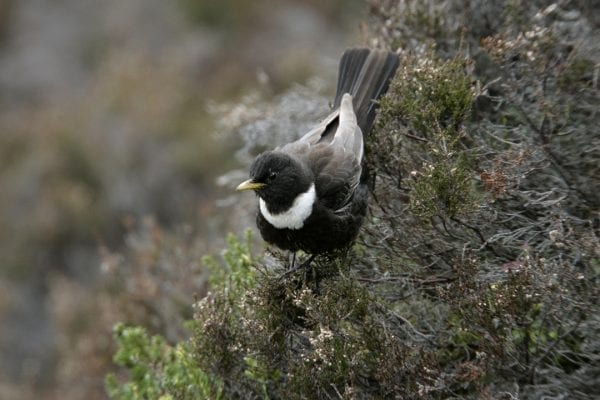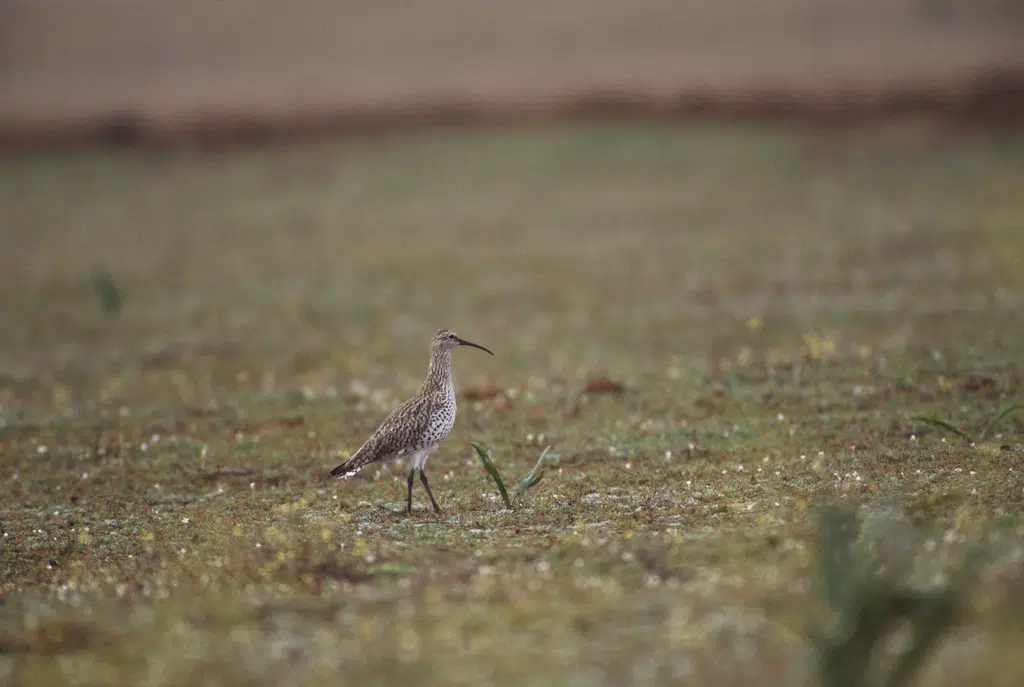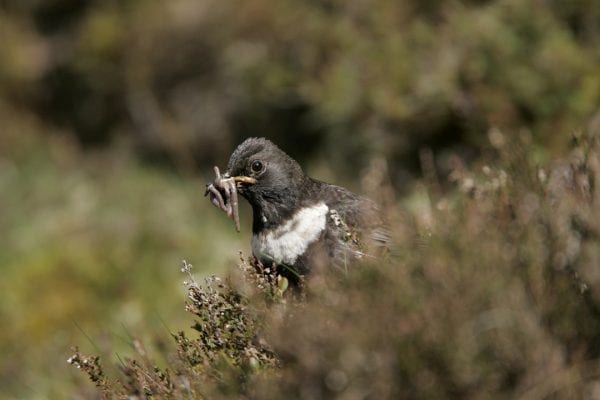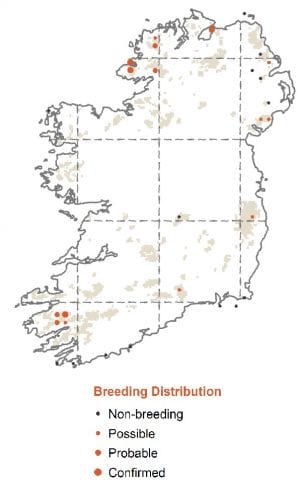
Ring Ouzel
| Irish Name: | Lon creige |
| Scientific name: | Turdus torquatus |
| Bird Family: | Thrushes |
red
Conservation status
Conservation status
Status
Rare summer visitor from mid-March to September to uplands, mainly in Counties Donegal and Kerry. Scarce passage migrant in spring and amount to coastal headlands.
Identification
The same size as a Blackbird. Adult males have glossy black plumage similar to that of the adult male Blackbird. Main difference lies in the broad white crescent on the breast. The wings also tend to be a more silvery colour than would be found on a Blackbird. Adult female Ring Ouzels are a more browner black colour than the males. The crescent is not pure white, more a beige-brown. First-winter Ring Ouzels are similar to adult females, but the crescent is an almost invisible brown smudge. The throat is white with black streaking. Ring Ouzels in the Alps have extensive white arrow markings on the underparts and some Ring Ouzels may have hints of these markings. However, there are as yet no definite records of Alpine Ring Ouzels in Ireland.
Voice
A harsh "tuck, tuck", as well as a Fieldfare like "chack". The song is a slowly delivered series of notes repeated two or three times.
Diet
Insects, especially earthworms. Also berries and other fruit including apples.
Breeding
Breeds on scree slopes in mountainous terrain with limited vegetation. Now restricted to only a handful of sites in Ireland.
Wintering
Wintering areas are poorly known, thought to be southern Iberia and North Africa.
Monitored by
Blog posts about this bird

Extinction of Slender-billed Curlew must be a wake-up call for global biodiversity action
In recent days, scientists sounded the death knell for Slender-billed Curlew, declaring the migratory shorebird globally extinct.
Published in IBIS, the International Journal of Avian Science, the analysis of the Slender-billed Curlew’s conservation status was a collaboration between RSPB, BirdLife International, Naturalis Biodiversity Centre and the Natural History Museum.
This is the first known global bird extinction from mainland Europe, North Africa and West Asia and, unless biodiversity loss is treated as the crisis that it is, it won’t be the last.
Indeed, the extinction of the Slender-billed Curlew should serve as a wake-up call to protect other vulnerable species from a similar fate.
What happened to the Slender-billed Curlew?
The Slender-billed Curlew was a migratory shorebird that once bred in western Siberia and wintered around the Mediterranean. A brown and beige wading bird similar in appearance to the Eurasian Curlew, it was distinguished by a striking flash of white under its tail, visible only in flight. As noted in the IBIS paper, records suggest that the Slender-billed Curlew was in decline as early as 1912, with the possibility of the species becoming extinct raised as early as the 1940s. However, it was not until 1988 that the species was identified as being of high conservation concern and classified as Threatened. The last undisputed sighting of the Slender-billed Curlew was in Morocco in 1995, despite extensive and intensive searches for the species since then. The recent research concludes that there is a 99.6% chance that this bird is now extinct. While the paper notes that the factors that led to the Slender-billed Curlew’s decline may never be fully understood, it points to possible pressures including extensive drainage of their raised bog breeding grounds for agricultural use, the loss of coastal wetlands used for winter feeding, and hunting, especially latterly, of an already reduced, fragmented and declining population. There could have been impacts from pollution, disease, predation, and climate change, but the scale of these impacts is unknown. Alex Berryman, Red List Officer at BirdLife International, and a co-author of the study, said; “The devasting loss of the Slender-billed Curlew sends a warning that no birds are immune from the threat of extinction. More than 150 bird species have become globally extinct since 1500. Invasive species have often been the culprit, with 90% of bird extinctions impacting island species. However, while the wave of island extinctions may be slowing, the rate of continental extinctions is increasing. This is a result of habitat destruction and degradation, overexploitation and other threats. Urgent conservation action is desperately needed to save birds; without it we must be braced for a much larger extinction wave washing over the continents.” It is now up to the International Union for Conservation of Nature (IUCN) to determine whether to officially declare this species extinct.Global shorebird declines
This news comes just weeks after an IUCN report revealed steep declines for migratory shorebird populations globally. 16 species of shorebird, including several species that winter in Ireland and are monitored through the Irish Wetland Bird Survey (I-WeBS), have had their conservation status reclassified to a higher threat category in the latest IUCN Red List update. Grey Plover, Dunlin and Ruddy Turnstone are among the species affected. Additionally, we know the seven other Curlew species share more than a name with the Slender-billed Curlew. Indeed, many other species of Curlew are experiencing declines. The last known sighting of an Eskimo Curlew was in 1963, when a lone bird was shot in Barbados. It is presumed to be extinct. Closer to home, the Eurasian Curlew has plummeted by over one-third in just 30 years, while central Asian populations have also experienced significant declines. Once a widespread breeding species in Ireland, a 2021 National Parks and Wildlife Service (NPWS) survey reported just 105 confirmed breeding pairs of Eurasian Curlew. This represents a 98% decline in breeding pairs in the Republic of Ireland since the 1980s. Habitat loss and degradation (as a result of agricultural intensification, land drainage and afforestation) have been identified as the primary threats to breeding Curlew populations in Europe. For decades, BirdWatch Ireland has spearheaded surveys and conservation efforts for Curlew and other breeding waders in Ireland. We also advocated for the introduction of a multi-million euro scheme which supports farmers to undertake measures aimed at saving Ireland’s breeding waders from extinction. We are pleased that the Government has responded, with the introduction of the Breeding Wader EIP earlier this year.Extinction in real-time
The devastating loss of the Slender-billed Curlew serves as a stark reminder that extinction is not some far-away concept. It is happening in real-time, on our watch, and within our own country. The Corn Bunting, a once common farmland bird, has been extinct in Ireland since the 1990s. Species such as the Hen Harrier are on the brink of extinction, with only 85-106 breeding pairs believed to remain in the country, while just one known pair of Ring Ouzel remains in Ireland. As previously mentioned, Ireland's breeding population of Eurasian Curlews is also in critical danger. Scientists know what needs to be done to reverse species declines and it is up to global leaders to step up and take meaningful action. This work must be collaborative and inclusive if it is to be effective. Migratory birds cross borders, so conservation efforts in one country can be undone by harmful actions in another that shares the same species.Giving nature a voice
Extinction is permanent. While it may be too late for the Slender-billed Curlew, some hope remains for countless other species, if we act quickly and decisively. As a member of the public, your choices and voice can help protect the future of many species still at risk. As we approach a General Election in Ireland, we encourage our supporters to prioritise the issues of biodiversity loss and climate change when engaging with and voting for their General Election candidates. You can find our list of asks for people, nature and climate in the next Government here. Featured Image: Slender-billed Curlew Morocco, Chris-Gomersall/rspb-images.com.
Sustained commitment to nature is needed to turn the tide on biodiversity loss
BirdWatch Ireland welcomes the €172 million package for nature and heritage announced as part of Budget 2025 this week, emphasising that the commitment to nature must be continued every year and by successive governments in order to turn the tide on biodiversity loss.
We welcome the fact that the overall funding package announced by Minister for Nature, Heritage and Electoral Reform, Malcolm Noonan marks an 11% increase on the previous year and represents a record budget for nature and heritage. Specific measures for nature in Budget 2025 include a 25% increase in NPWS funding from 2024, bringing it to a total of €78 million. €29 million of this will be used for protection and restoration at National Parks and Nature Reserves, while €6.5 million has been ringfenced for Science, Research and Nature Protection.
The budget increases for nature have been a welcome hallmark of this government after years of poor investment. It is essential that the spend on nature-related actions and staff resources, be increased significantly and these increases sustained annually to tackle the scale of the environmental crisis we face.
“I was very pleased to see the recent budget settlement and the overall increase in funding for nature. However, it is vital that this trajectory is repeated each year going forward. A sustained commitment to nature, underpinned by a robust budget and science-led decision-making, is essential if we are to have any real chance of halting species declines and habitat loss. Moreover, this ongoing commitment is vital if Ireland wishes to meet its legal obligations under national and EU law,” says CEO of BirdWatch Ireland Linda Lennon.
Current and future Irish governments need to continue to back nature without exception. There is simply no time to waste.
“This week, the Environmental Protection Agency published its eighth State of the Environment Report in Ireland since 1996. In stark terms, it outlined yet again the dire situation many wild birds face. It reminded us that for our protected and internationally important habitats, only 15% are in good condition. Ireland is one of the worst-ranked countries in the EU for poor habitat quality. Our Dáil Éireann-declared biodiversity emergency is not an exaggeration. The restoration actions that are being taken must be scaled up for years to come so we can rebuild ecosystems to help people and wildlife be more resilient to the effects of climate breakdown,” says Oonagh Duggan, Head of Advocacy at BirdWatch Ireland.
The 2020-2026 Birds of Conservation in Ireland (BoCCI) assessment showed that 26% of Irish bird species are now on the Red list, indicating the highest level of concern for their populations. Species such as the Hen Harrier are on the brink of extinction, with only 85-106 breeding pairs believed to remain in the country, while just one known pair of Ring Ouzel remains in Ireland. Such devastating declines are coupled with the loss and degradation of habitats, even in areas that are deemed legally protected. Restoring habitats and reversing species declines cannot be achieved in a matter of months, or even one Government term. We are eager to see an ongoing, long-term commitment to nature that is embraced by all parties.
Indeed, we have already made a pledge to restore nature. By passing the hard-fought Nature Restoration Law earlier this year, Ireland and other member states committed to restoring 20% of the EU’s land and sea areas by 2030 and all ecosystems by 2050. Now that it has been formally approved, Ireland will be required to draft our national restoration plan and lay out in detail how these targets will be reached.










